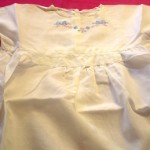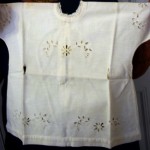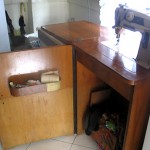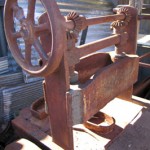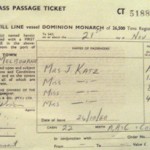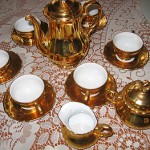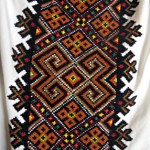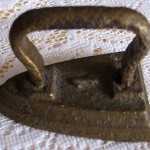Italian
Arsiè, Belluno, Italy
Genoa, Italy on 24 February 1961
Sydney on 28 March 1961
Surry Hills, Sydney
Dressmaker working from home, Surry Hills, Sydney
Owner of Gelateria Arena coffee shop in Beaumont Street, Hamilton, Newcastle
My name is Silvia Saccaro and my maiden name was Silvia Bettin. I was born in 1933 in the village of Arsiè in Belluno province, Italy.
In my village, I was doing embroidery with the nuns and later I went to learn to be a dressmaker. I worked from 16 until 22 years of age as a dressmaker in the village. The money was not very much so I went to work in Switzerland in a carpet factory. I was putting the wool onto the spools to make the skeins of wool while others were spinning. I worked there five years and came back to Italy at age 27.
Then I came over here to Australia at 28 to get married. My fiancé, Rigo, was already here as he came out in 1957 with his family; his father, mother and brother. I left two sisters behind and they are still alive; one is 86 years and one is 82 years old — I was the baby of the family. I grew up with my husband in Arsiè. We [started] kindergarten together at the little village school.
I brought three trunks and three suitcases when I came to Australia. I also brought a box with a 72 piece [dinner set] that my sister gave to me as a wedding present. In the trunks, there were a lot of my glory box things — my dresses and things for the house. There were coffee cups and a teaset that my mother gave me and silver cutlery. I also brought out a lot of embroidery things.
I was 11 when I started to do embroidery in my village in Italy. We learnt with a nun from the village who specialised in this work which is called Burano lace. There is a museum in Burano near Venice showing old Burano lace. They are still making it there though very few people are doing it. The nun told us [Burano] lace was once more expensive than gold. It is done with very, very thin cotton and because it is so thin, it takes very long to embroider. I made this tablecloth embroidery but also placemats and doilies. My eldest sister was doing the same thing too. Just one of these patterns on this cloth would take about 20 days. The bigger ones would take about one month.
This other dress was made by my mother for my sister when she was a baby. It has been handed down through our family and it is very special. There’s a photo from my mother of my sister with our uncle, and she is standing up on a chair with this dress on. The pillowcase is also from my mother’s family and has her family crest on it; ‘MF’ for Maria Faoro.
It is important for me to keep these objects for sentimental reasons; when you are away from your family every little thing counts. You remember your mother and your sisters and the things that they have made or done for your children. When you see these things there is something there about the heart and you appreciate everything. I get attached to everything for sentimental reasons. It is very important.
There were things in the house I would have liked to have brought with me. My mother and father were happy to give it to me but with the long trip, it was impossible. I brought my sewing machine though! It is a Singer machine and it was bought in Italy in the beginning of the 1960s, so it is about 49 years old.
I came to Australia in 1961. I departed from Genoa on 24 February and I arrived in Sydney on 28 March. My journey was on the ship Australia and I have a postcard here of the ship purchased during the voyage.
When [I] arrived in Sydney my husband came to pick me up in the morning at the port and he took me to Surry Hills where we rented a house.
We came up here [to Newcastle] to get married on 3 April 1961, in St Lawrence’s Church in Broadmeadow because his family was living in Hamilton. Father Tiziano Martellozzo celebrated the Italian mass for us at our wedding. He was our priest and a very good person. He has now retired because he is over 80 years of age.
When we were living in Sydney my husband was working in restaurants and I was sewing from home in Surry Hills. I made a wedding dress for my cousin and dresses for other Italian ladies living around the area. I also sewed things for my children and for friends.
While living in Sydney and 10 months after my marriage, I had my first daughter, Cinzia. I made this nightie for her when I was in Surry Hills. After another 16 months, I had my second daughter Delia – very quick! In three years, I had three children. My son Alan was the last.
After some time we moved from Surry Hills and we bought our own house in Earlwood, near Canterbury [in Sydney’s south-west]. We lived there until 1970. Then we came to live up here in Newcastle. We first moved into my father-in-law’s house for a few months and then we bought this house and we are still here!
We came to live up here because my husband’s mother died in 1969 and his father was lonely. The other reason was a little coffee shop in Beaumont Street, Hamilton called Gelateria Arena, which we bought. We worked there for 20 years, my husband and myself. I was the cook and the girls helped after school. My children went to Hamilton Public School and then to Merewether High School. I was working in the coffee shop six days a week and looking after the house and the children. Sunday was spent cleaning in the shop because it was the only day that it was closed. It was a hard life; lucky I was young or I couldn’t do it.
I am pleased I came out to Australia because in Italy where we lived, there was only the little farm and the house belonging to my parents. But here we got our own house and we improved [our lifestyles]. And being in Australia was good for my children especially. Here, everybody gets an education; back in Italy, it is a bit more difficult.
I never learnt the English language properly because Italian people were always coming into the shop and all day I was listening to Italian. I can communicate but sometimes I think, “All these years in Australia and I can’t speak proper English”.
I am also with a lot of the [Italian] people because I am the president of the Italian choir, which has been going since 1951. On Wednesday, we practise choir, and then we will sing at funerals and nursing homes. Also, I do voluntary work serving meals to older Italian people at the centre in Broadmeadow. The centre had to move from Hamilton about five years ago and now they are settled and we have facilities and air-conditioning.
And I enjoy life, you know.
My mother used to say to me that when you go to live in one country you have to settle and follow the way they live otherwise you will never be happy and that is what I do. You could say, “Oh! Italy this and Italy that,” but we are living here and if you don’t like it, go back.
My roots are still there in Italy and it’s always in my thoughts. It is in your mind that you are a migrant, but my children are Australian and I am settled here. I write to my family in Italy and I have been back eight times.





!["I brought three trunks and three suitcases when I came to Australia. This trunk is from Switzerland and was used to carry my glory box items. It was [later] used to store my daughter's glory box items."](../../../cms/wp-content/uploads/2009/09/saccaro-glory-150x150.jpg)
!["I made this tablecloth embroidery. I was 11 when I started to do embroidery in my village in Italy. We learnt with a nun who specialised in this work, which is called Burano lace. The nun told us [it] was once more expensive than gold. Just one of these patterns on this cloth would take about 20 days."](../../../cms/wp-content/uploads/2009/09/saccaro-lace-150x150.jpg)
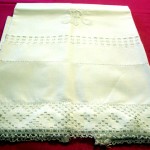
!["I departed from Genoa on 24 February and arrived in Sydney on 28 March, 1961. My journey was on the ship Australia and I purchased a postcard [of it] during the voyage."](../../../cms/wp-content/uploads/2009/09/saccaro-postcard-150x150.jpg)
